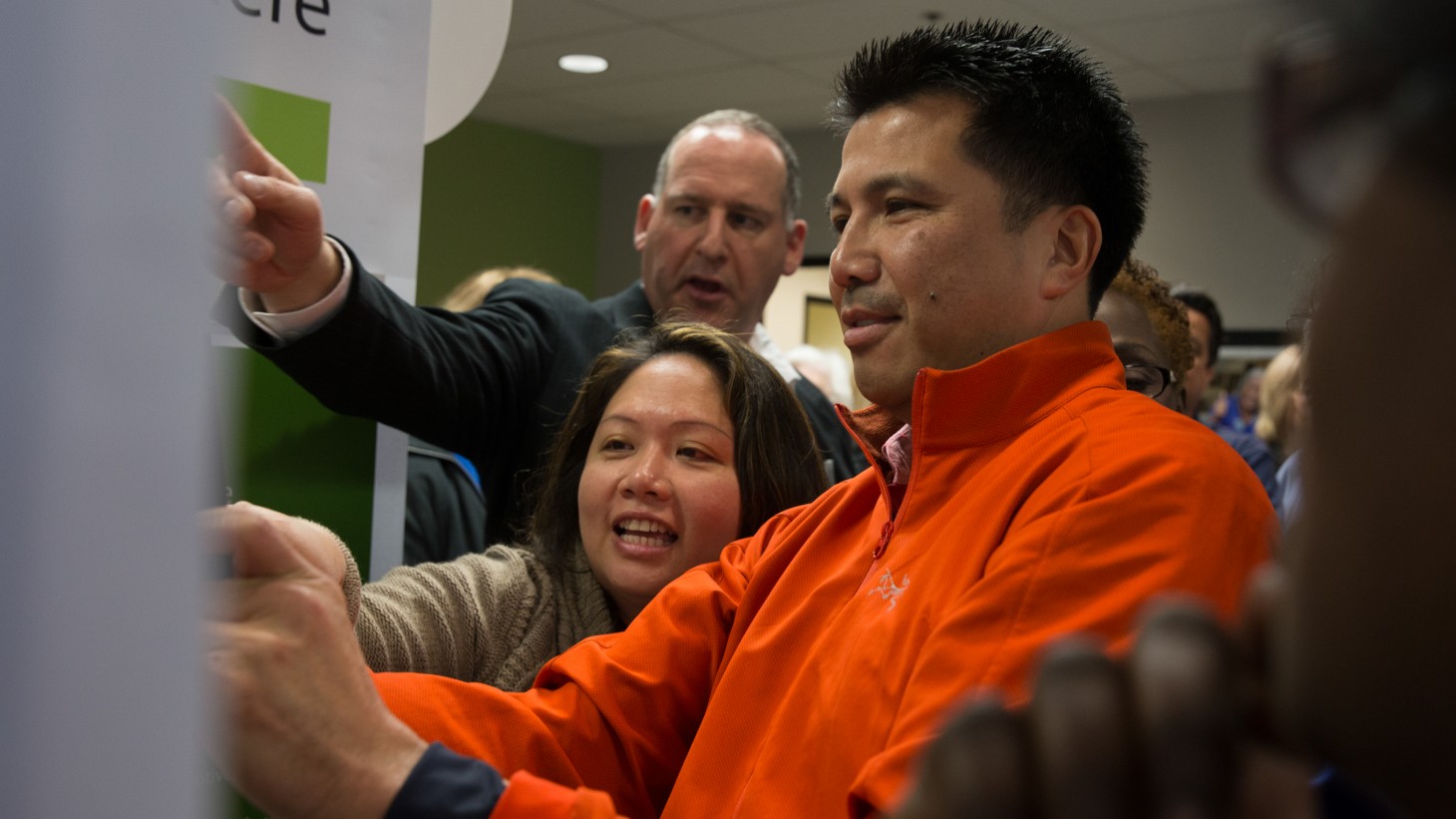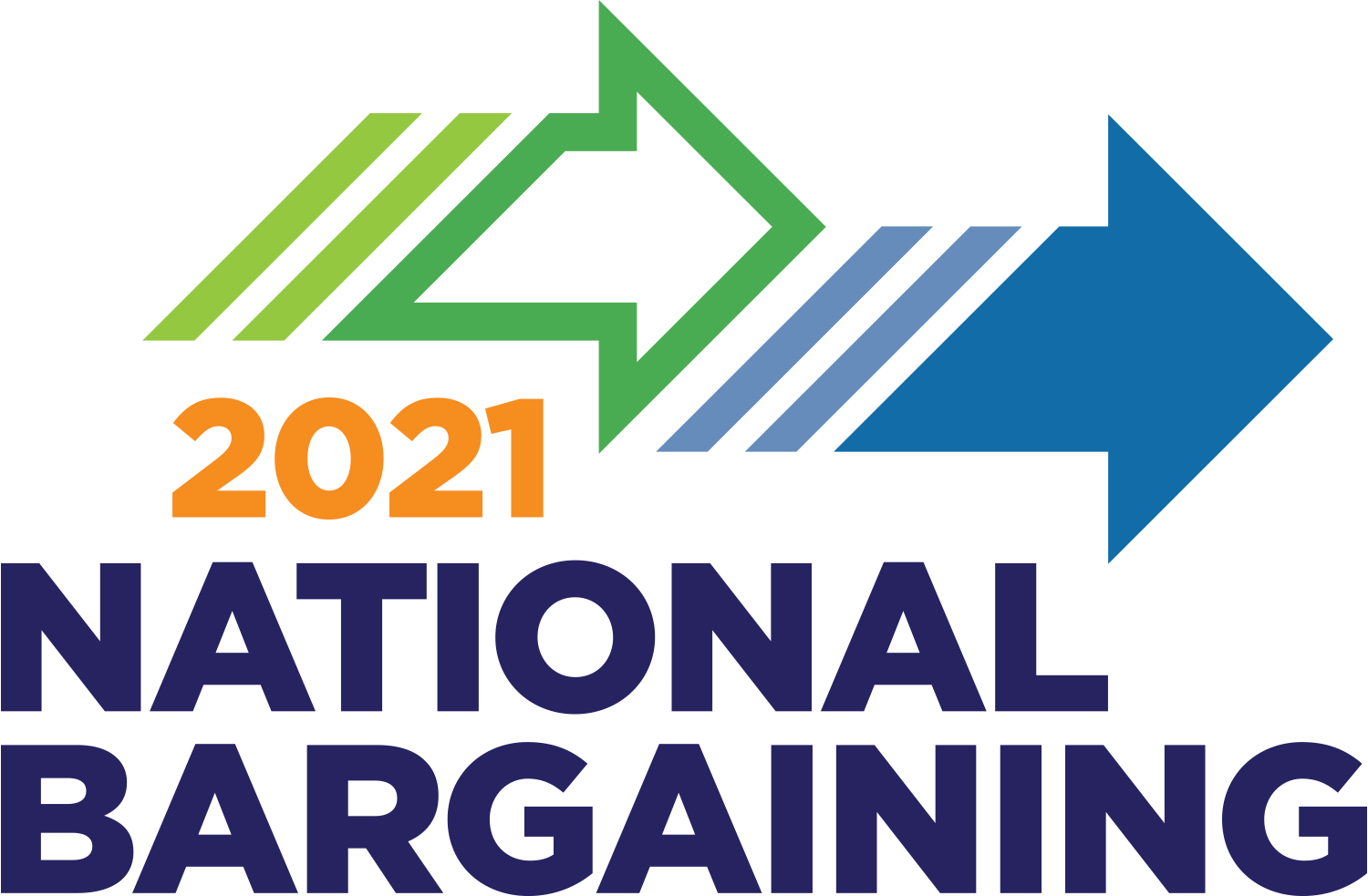Staying Nimble With Innovation From the Frontlines
Decoding the Future

Gerard Corros, RN, and his UNAC/UHCP colleagues check out the Imagining Care Anywhere exhibit.
Jobs are changing, fast. How do you prepare when you don’t know what the change will be?
See your doctor without leaving home? The house call of the future may be via your smartphone.
A visiting home health care nurse may one day live-stream exam information via a wearable device like Google Glass, speeding up the treatment process.
Or maybe you’ll be dropping in for a check-up at the clinic in your local shopping mall.
No one can say for sure which ideas will take hold, how long before those ideas morph again and how jobs will be affected. The good news is, we’ve successfully managed widescale change before.
“Changes in health care mean there will be job losses and job growth,” says Jessica Butz, the Coalition of Kaiser Permanente Unions’ national program coordinator for Workforce Planning and Development. “But in the long run, the new skills needed are good for workers and for our patients and members. We have options and support to make the transition work for us, and we’ll have better, more secure jobs.”
Joyce Lee, a Steelworkers Local 7600 member and a former imaging transcriptionist at Fontana Medical Center in Southern California, can speak to the truth of that. Four years ago, a new voice-to-text technology made her job obsolete. She now works as a phlebotomist, a job she always wanted.
“One of the things I’ve always loved about Kaiser is that you can have many careers here, you can be as good as you can be,” Lee says. “I got great support from my union, my manager and my career counselor.”
In the mid-2000s, thousands of workers across the organization saw their work vanishing as KP HealthConnect® was introduced. Time and again, Labor Management Partnership resources and safeguards not only kept individuals employed, but led to new skills and jobs within Kaiser Permanente that paid as well or better.
As KP implements new care delivery models, having a workforce planning and development program that draws on the input and experience of the workforce will help ensure smoother transitions and keep costs down.
“We want individual workers, teams and the whole organization not merely to survive change, but to thrive on change. We used partnership to do just that with HealthConnect,” says Hal Ruddick, executive director of the union coalition. “We don’t need to reinvent the wheel—we just need to get rolling on joint planning and implementation.”
Early engagement required
What all the new care models will look like is still taking shape. Despite the uncertainties, leaders recognize the need to start thinking now about how changing technology will affect the workforce. It’s becoming clear people will need to be trained for team-based care, to work seamlessly across different care settings and be technologically skilled or able to learn those skills.
“We have an opportunity—both labor and management—to lead on the new care models and to get ahead of those changes and get it right,” says Zeth Ajemian, the director of Workforce Planning and Development for Southern California and Hawaii. “It requires early engagement and flexibility.”
Remembering what we’ve already learned will help. The implementation of both KP HealthConnect and the coding process known as ICD-10 provides valuable case studies.
In 2009, the U.S. Department of Health and Human Services announced a big change for health care providers: The International Classification of Diseases, 9th Edition, known as ICD-9, would be replaced by ICD-10, which contains about 144,000 diagnosis and procedure codes. The changeover, now scheduled for Oct. 1, has meant 166 applications—including billing and claims systems in each region—needed to be upgraded, replaced or retired.
In addition, some 1,400 coders and many others needed retraining. Union coalition members are covered by the Employment and Income Security Agreement, which provides for retraining, redeployment and at least one year’s protection from layoffs due to process improvements or restructuring.
“Our ability to work collaboratively in partnership—and recognize workforce issues as part of our strategy—is huge,” says Laura Long, the director of National Workforce Planning and Development. “We need to look at the impacts on the workforce and the skills sets needed for the future. We can’t just flip a switch.”
Identifying potential problems
So KP and the coalition took a page from the KP HealthConnect playbook, when Kaiser Permanente leadership reached out to the unions.
“We had conversations about why the change was important and what it would look like,” says Marie Hamilton, RN, who was the national labor coordinator for KP HealthConnect implementation and is now the labor partner for OFNHP at Westside Medical Center in the Northwest. “Part of the implementation was making sure people got the skills they needed.”
The process was not pain-free, but by engaging the workforce, she says, “Kaiser got buy-in from the people using the system and identified potential problems early on. It was the most impressive thing I’ve seen in 40 years at Kaiser—a model that demonstrates how working in partnership can effectively manage sustainable change.”
When that engagement is missing, the repercussions can be far-reaching. Last year, for example, a decision to reduce or redeploy nurses in Southern California led to a pull-back in union support for unit-based teams in the region. The dispute was resolved, but it illustrated the risk of going it alone.
“In times of change, it can be tempting for both sides to fall back on old habits and traditional approaches—and we know where that gets you,” says Dennis Dabney, the senior vice president of National Labor Relations and Office of Labor Management Partnership. “The test of any partnership is working your way through tough issues and getting better results. That's what we are committed to do."
The joint approach to ICD-10 has included national “communities of practice”—with representation from frontline workers—to design training and make policy and budgeting decisions. Regular updates keep affected employees informed and let them air concerns.
One very specific payoff to the approach: The labor-management team in Colorado found serious flaws in a claims and billing system being developed by outside vendors. KP switched vendors and avoided a potentially disastrous disruption.

In times of change, it can be tempting for both sides to fall back on old habits and traditional approaches—and we know where that gets you. The test of any partnership is working your way through tough issues and getting better results. That's what we are committed to do.
Workforce planning is key
The changes now unfolding in health care require innovation—not just in workforce development, but also in workforce planning.
“We are starting to know what kinds of skills will be needed,” says Daniel Goldberg, senior director of Workforce Planning and Information Management. “And we know that continuing education, credentialing and critical thinking will be more and more important for all health care workers.”
Information gaps remain, he says. For instance, there’s not much known on a system-wide basis about the educational status and competencies of current workers.
One step in the right direction was the creation of the Jobs of the Future Committee, a recently formed group of operational leaders, training leaders, HR directors, technical experts and union representatives in Southern California. The committee will identify promising care innovations, develop plans to support and staff them, and help workers adapt to them before the wave of change hits.
“Compared to other industries, technology and innovation were late coming to health care, but they’re here now,” says Ajemian, who chairs the committee. “There are a lot of groups at KP working on exciting innovation projects focusing on the transformation of care delivery. But if we don’t plan early for staffing and recruitment, we won’t have an adequately prepared workforce.”
